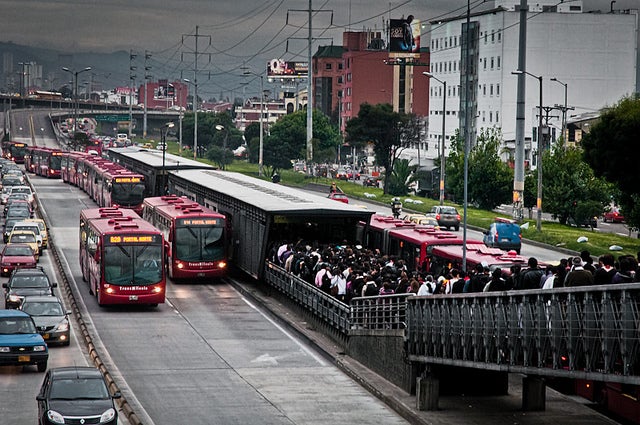If you miss me at the back of the bus, and you can't find me nowhere
Come on up to the front of the bus, I'll be ridin' right there
I'll be ridin' right there
I'll be ridin' right there
Come on up to the front of the bus I'll be ridin' right there
These lyrics from the Civil Rights movement back in the 60s’ spring to mind as we debate the role and importance of public transport in moving toward livable, green cities. When they were written, and then recorded by Pete Seeger who popularized the tune, public transport was to a large extent a mirror of the prevailing social hierarchy—white in the front, colored in the back. Of course, times have changed, or so we like to believe. But how far ?
I am just back from the Center for Mediterranean Integration in Marseilles, France, where the Bank, together with the French Agency for Development (AFD), delivered the first French edition of the Leaders in Urban Transport Capacity Building program. This comprehensive program, blending self-learning with face-to-face training and individual mentoring, has first been offered to an English speaking audience in Singapore in January 2012. The very positive feedback it generated led us to consider developing French and Spanish versions to expand its outreach across Bank’s client countries.
Thirteen countries were represented in Marseilles, where thirty public executives and elected decision-makers gathered to go through this one-week long program. While we went through a series of case studies discussions and exchanges of experience, some evidence accumulated underscoring a few critical aspects of problem-solving strategies when it comes to urban transport.

First, as tempting as it may be, throwing more capacity at congestion does little in itself to alleviate the problem—if it does not make it worse by inducing more traffic. New ring roads make for nice pictures—and rewarding inaugurations—but are unlikely to dent rush hours back-ups. Even costly mass transit systems, as effective as they might be, will most often only be a drop in the bucket when compared to the magnitude of daily trips a metropolitan city generates.
Second, even when public transit is available, there is no guarantee it will be used to its maximum extent: modal choice for individual mobility is and will remain an individual decision. Twenty years ago urban transport projects in the developing world were mostly designed to provide access—to jobs, markets, social services—for people who had none, living on the fringes of big cities and often severed from the economic and social fabric of the community. This remains a relevant objective, but today we got another: provide an alternate mobility option for those well-off enough to afford a personal car. And obviously, levels of service expectations will vary greatly between those two broad target groups. Whereas the poor will probably welcome a public transport option coming to them provided it is affordable, happy car owners will think twice before opting for a public transport option that may not be as comfortable and convenient as their beloved vehicle—even when stuck in traffic. So policymakers will have to help them make the right choice. And since the lofty goal of saving the planet from asphyxia, while drawing universal applause, may still fall somewhat short of triggering the spontaneous adhesion of millions of commuters to the hidden charms of public transport, different kinds of incentives, more wallet-oriented, are in order. In politically correct economic wisdom, this is called demand management. In other words, play nice or pay more.
Third, and finally, when our commuter, under the combined pressure of heroic idealism and household economics, bravely opts for public transport, chances are he will find….a bus.
And this is where we fall back on our social hierarchy metaphor. In short, still today in many countries rail-based transit is the mode fitting social achievement, the mobility mode consistent with aspirations towards a middle-class standard of living. Conversely, buses are for the unlucky ones still unable to set their sight on this golden horizon—buses are for the poor. Hence all the efforts deployed to brand bus rapid transit lines (BRTs) as metro-on-wheels, to escape the wheels-only stigma. But as said before, even BRTs will not provide the coverage and capacity needed to cure the problem. To achieve this, you will need to rationalize the regular bus systems.
So the bottom line is simple to write, if less so to act upon: to sustainably improve urban mobility based on a long-lasting modal shift, beyond building mass rapid transit systems, beyond developing bus rapid transit lines (BRTs), you also must reorganize and modernize the regular bus networks. Only then will the high-capacity lines really help, when the regular buses schedules and lines feed commuters onto the main trunk lines. Granted, it is far less rewarding than cutting a ribbon on a new metro station, far more difficult than choosing the color of the new BRT articulated buses, which is why it is regularly mentioned in cleverly crafted action plans that, apart from being unearthed to be updated every five years, mostly make the stuff of dreary seminars where serious experts agree this is absolutely the thing to do, before shelving them back and moving to more exciting endeavors.
So….if you miss me at the back of the bus, well, you’ll know where to find me.
Keep moving !


Join the Conversation